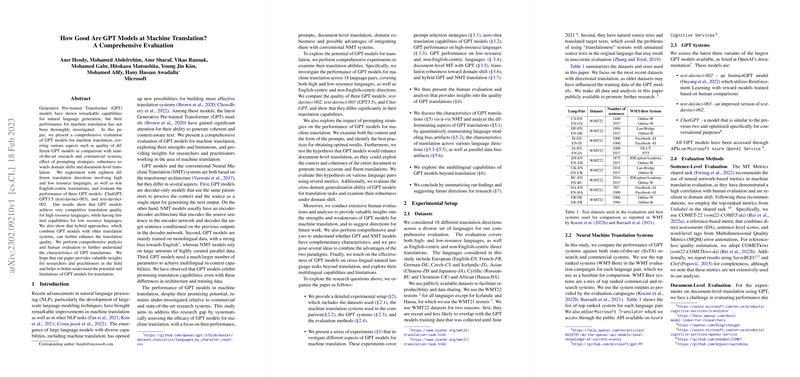An Evaluation of GPT Models for Machine Translation
The paper "How Good Are GPT Models at Machine Translation?" presents a comprehensive evaluation of the multilingual capabilities of Generative Pre-trained Transformer (GPT) models for machine translation. This paper addresses the critical gap in the assessment of GPT models' efficacy in translation, benchmarking their performance against state-of-the-art research and commercial systems and analyzing prompt strategies, robustness to domain shifts, and document-level translation capacities.
Methodology and Experimental Setup
The researchers evaluated three prominent GPT models: ChatGPT, GPT3.5 (text-davinci-003), and text-davinci-002. They employed a thorough experimental setup involving 18 language pairs, including both high- and low-resource languages and non-English-centric translations, using the latest WMT22 test sets with clear distinctions between natural and translational text origins. The paper utilized COMET-22 and COMETkiwi, alongside traditional metrics like SacreBLEU and ChrF, to evaluate translation quality, factoring in sentence and document levels.
Key Findings
- Translation Performance:
- GPT models demonstrated strong performance for high-resource languages, especially in zero-shot configurations, with ChatGPT and GPT3.5 outperforming text-davinci-002.
- Few-shot learning with quality prompts showed improvements, yet these gains were limited in translating from English to other languages, with 5-shots often yielding marginal benefits over zero-shots.
- Prompting Strategies and Document-level Translation:
- High-quality prompts and relevance-driven selections greatly enhance translation capabilities. However, further improvements from additional shots were inconsistent across language pairs.
- Document-level translation benefits from increased context window sizes, showing potential over sentence-level translation, especially when computational efficiency is considered.
- Domain Robustness and Hybrid Systems:
- The GPT models displayed robustness across varied domains, with notable strength in conversational tasks.
- A hybrid approach, combining GPT with traditional NMT systems, demonstrated significant quality enhancements in translation, indicating a pathway for future system integration that maximizes the strengths of both paradigms.
- Language Characteristics and Biases:
- GPT translations were often more fluent and non-monotonic than their NMT counterparts, exhibiting a propensity for punctuation insertions and higher non-aligned source words.
- The analysis also highlighted that GPT could better handle translations with noisy or ill-formed inputs, providing advantages in specific domains usually affected by parallel data biases.
- Beyond Translation - Multilingual Capabilities:
- The paper extends GPT's evaluation beyond translation to multilingual reasoning tasks, revealing limitations in reasoning tasks across non-Latino languages, suggesting differential support based on the model's training data distribution.
Implications and Future Directions
The findings highlight the competitive translation ability of GPT models for high-resource languages while underlining the challenges in achieving equivalent performance for low-resource languages. The integration of GPT in hybrid systems offers a promising model for enhanced translation quality, suggesting a significant potential for task-specific optimization and system efficiency improvements. The paper also underscores the need for better evaluation metrics that transcends simple lexical comparisons to truly capture the nuanced context and fluency of GPT outputs.
Future research should focus on three central aspects: enhancing support for underrepresented languages, refining in-context learning strategies for more nuanced linguistic outputs, and developing more sophisticated fusion techniques for hybrid systems. Additionally, the exploration of the relationship between translation capabilities and broader multilingual tasks warrants deeper investigation to achieve more equitable AI systems across language spectra.
